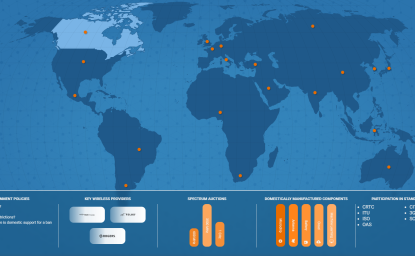Video: Who is Driving the 5G Transition in North America?
Who is driving the 5G transition in North America? A quick look at some of the key policies informing 5G rollout from the US, Canada and Mexico.
Who is driving the 5G transition in North America? A quick look at some of the key policies informing 5G rollout from the US, Canada and Mexico.
As fifth generation wireless technology is rolled out across North America, new public policies will be necessary to address challenges and opportunities in three primary areas: spectrum, deployment, and security.
While broad spectrum usage is set at an international level, decisions on licensing and auctions are national level concerns. Spectrum allocation is the process of determining which wavelengths will be available for commercial use and which wireless carriers can deploy 5G over certain wavelengths. Particularly because certain bands are reserved for government use, the competition is fierce to secure desirable bandwidths, and the auction process is key to ensuring companies awarded spectrum will support national objectives for network buildout.
Part of the standard will address broader coverage, including to areas that were previously left behind. High frequency, including millimeter wave (mmWave) wavelengths often used for 5G do not travel as far as lower frequency wavelengths, meaning that with strategies focused on mmWave, rural areas are more difficult to cover. And with limited financial incentive to build in less populated areas, there is risk that 5G will exacerbate the urban-rural divide in access to telecommunications. Governments are addressing this market failure through different targeted interventions.
5G deployments also have environmental impacts -- through their power usage and the physical impact of constructing towers -- and policy approaches must weigh the time costs of environmental compliance against speeding ahead in their race to 5G. Additionally, varying local requirements, such as permitting and public review processes, can impact the speed of 5G rollout, and there have been actions to decrease carrier compliance requirements and speed municipal review.
With the increased complexity of 5G networks comes enhanced security risks. In general, the augmented complexity of 5G networks from both a hardware and software perspective, leads to a greater risk of vulnerabilities. The integration of the software and hardware for the network means that new technologies are necessary to check the millions of lines of code that the systems run on. 5G technology will only be as strong as its weakest link, meaning that the integration with legacy telecommunications technology and infrastructure will continue to pose security risks to new 5G solutions. Additionally, 5G networks incorporate advanced remote access and automated functions, creating new threat vectors for malicious network attacks. Malign actors could intercept data being sent over the network or damage the network itself, with severe implications to national security. Policy approaches to address the security concerns vary, and include restricting 5G equipment vendors in the US to implementing equipment checks in Canada.
While collaboration across North America will be required to maximize the benefits of 5G, the United States, Canada, and Mexico have unique policy responses to the challenges and opportunities 5G brings.
The US has adopted a market first strategy and is supporting private sector build out of 5G, beginning with the Federal Communications Commission’s (FCC) 5G FAST Plan. Leading the US approach for spectrum allocation and imposing time limits on local 5G deployment, the 5G FAST Plan also aims to minimize regulatory hurdles. To support national security and market diversity, the US has focused on securing the supply chain for domestic rollout and, in the 5G and Beyond Act of 2020, is committing to cooperation with allies on international standard setting.
The FCC recognizes commercial access to spectrum as a key driver to 5G leadership, and made “pushing more spectrum into the marketplace” the first priority in the agency’s 2016 5G FAST Plan. The FCC initially focused on allocating mmWave, in part because sub-6 spectrum in the 3 and 5 GHz range is exclusively allocated to agencies including the Department of Defense (DoD). Critics have argued that prioritizing mmWave, which can only travel short distances and may be blocked by walls or other barriers, limits the value of 5G outside urban environments. In addition, scientists from NASA, NOAA and academia have petitioned Congress that active mmWave transmission threatens weaker, passive signals required to carry data from satellite observation systems back to Earth.
In 2019, the FCC auctioned off the first mm-Wave spectrums, 24GHz and 28GHz, and has powered forward in 2020 to make spectrum available commercially. In March, the 37GHz, 39GHz, and 47GHz were auctioned, netting $4.47 billion in proceeds and forming the largest spectrum auction in US history. The FCC has recently made the prime mid-band spectrum available, opening licences for 3.5-3.6 MHz bands. The US was a late mover on releasing the mid-band yet this auction is a crucial step to harmonizing international spectrum allocation.
The FCC’s second priority is to speed up federal and local review of 5G network deployments, and increase private sector investment. To decrease carrier costs, in 2018, the FCC limited federal requirements of new small cell 5G deployments under the National Historic Preservation Act and National Environmental Policy Act, and decreased carrier fees to Tribal Nations. However, the deregulation was overturned in 2019 due to concerns over environmental and historic preservation impact. To streamline local deployment, the FCC placed ‘shot clocks’ on municipalities to give approval decisions on carrier applications for small cell deployments within a deadline. The FCC’s orders strongly emphasized speeding local processes, banning municipalities from creating barriers to broadband deployment, and decreasing carrier fees to municipalities. This met significant pushback from cities, who filed suit against the FCC in 2018 claiming federal overreach. The court has upheld the FCC’s orders, with one exception: cities won back aesthetic control over small cell deployments. The FCC’s third priority is to update regulations by promoting the expansion of networks through shifting Internet Service Provider regulation from a utility-based approach to a market-based approach. In turn, lifting rate regulation on fiber networks for business and imposing ‘one touch’ requirements on carriers to expedite removal of old equipment. To support 5G in rural areas, the FCC proposes allocating $9 billion to establish a 5G Fund for Rural America, but is still assessing the gaps in basic rural mobile coverage through the Digital Opportunity Data Collection (DODC).
While the FCC’s 5G FAST Plan was a foundational domestic policy, later efforts have focused on 5G security, supply chains, and international leadership. In 2019, the Executive Order on "Securing the Information and Communications Technology and Services Supply Chain" declared a national emergency prohibiting any financial transactions around information and communications technology (ICT) “in which any foreign country or a national thereof has any interest.” Furthermore, the ban includes any technology or service that is “designed, developed, manufactured, or supplied” by a foreign adversary that may cause undue or unacceptable risk to US ICT or national security.
Finally, the 5G and Beyond Act of 2020 requires the president to develop a strategy on wireless networks to ensure the security of 5G and future generations of wireless technologies within the US, as well as to help mitigate security concerns for mutual defense treaty allies, strategic partners, and other countries by providing technical assistance. The 5G and Beyond Act also seeks to advance American competition, emphasizing the role of the private sector and encouraging leadership through participation in standards-setting bodies and processes that ensure both security and privacy requirements are met. While recognizing the role of FCC leadership, the 5G and Beyond Act identifies a much broader range of responsible parties including the President, Secretary of Commerce, Secretary of Homeland Security, Director of National Intelligence, Attorney General, Secretary of State, Secretary of Energy, and Secretary of Defense.
Backed with high-growth innovation hubs and a highly skilled workforce, Canada has taken a market driven approach to 5G combined with government support to encourage public applications of 5G technologies. The Innovation, Science and Economic Development Canada (ISED) leads spectrum allocation and investment, prioritizing bandwidths for rural areas, rapid deployment, and research on efficient spectrum usage. Canada’s security policy is still under review, but processes are in place to test equipment, review vendors, and ensure security of those critical components.
In Canada, ISED is carrying out the 2007 Spectrum Policy Framework for Canada objective to “maximize the economic and social benefits that Canadians derive from the use of the radio frequency spectrum resource.” The policy approach relies on market forces when possible, but emphasizes the need for regulation to support public interest applications, such as safety, and to harmonize spectrum with international standards for globalization. The government is investing $199 million over five years to update spectrum equipment and processes. The low-range 600 MHz band was auctioned in 2019, and the mid-range 3500 and 3800 MHz bands will be up for auction in 2021 and 2022, respectively. The mid-ranges will support broadband connectivity in rural areas, in accordance with Canada’s Connectivity Strategy. The auction for the high frequency mmWave band, 3500 MHz, is planned for 2021. The licensing is being designed to support long-term digital economic growth, particularly through the development of technologies that will run on top of 5G.
5G rollout is guided by Canada's Digital Charter, focusing on bringing connectivity to all Canadians and accelerating the adoption of new technology. Canada’s large landmass and scattered population has made widespread connectivity an obstacle for government, industry, and many Canadians. 5G deployment plans target bringing online the 16% of households without high-speed internet access, raising Canadian firms’ ranking on e-commerce, and decreasing the high consumer costs of mobile connectivity. In 2019, the Canadian information communication technology sector accounted for 4.8% of national GDP and grew by 4.9%, outpacing overall Canadian economic growth by over three percentage points. Under the Accelerated Investment Incentive, the government is encouraging job growth in sectors including telecommunications and helping promote 5G rollout. Furthermore, small cells are designated as “Non-Tower Structures,” speeding up 5G rollout by excluding the cells from certain land-use authority and public consultation requirements. ISED’s Communications Research Centre is heading three “grand challenge” projects for 5G: environmental monitoring of spectrum usage, spectrum sharing and allocation to better use the limited resource, and technology development to allow use of new spectrum bands.
In 2018, Canada began an intragovernmental analysis of the security risks of 5G. Canada is still reviewing its security policy and has not yet decided which vendors’ equipment will be allowed in the network. Canada has implemented a Security Review Program, conducted by the Communications Security Establishment (CSE) to assess 5G. Through this program, certain equipment has been banned from use in critical networks and mandatory testing for equipment has been conducted in independent labs. The Canadian Security Telecommunications Advisory Committee (CSTAC) has brought together private and public sectors to build security standards for critical infrastructure, including 5G, and vendor management standards for Canadian Telecommunications Service Providers. While there is no official or conclusive government ban on specific 5G equipment, the Canadian government has invested significantly in Nokia Canada projects, including cybersecurity for 5G, and all three top telecommunication companies will be using European suppliers.
Mexico’s Federal Telecommunications Institute (IFT) is paving the way for new 5G-enabled technologies, like IoT and Artificial Intelligence through early release of spectrum. Access to telecommunications services is guaranteed in the Mexican constitution, and the government complements private 5G build out with the public-private network, Red Compartida, aimed to provide rural connectivity. Mexico has not issued bans on specific vendors, and uses a variety of equipment in its networks.
In Mexico, spectrum allocation for 5G is led by the Federal Telecommunications Institute, guided by the objectives set out in the National Program for Radioelectric Spectrum 2019 – 2024. The plan aims to increase spectrum to support universal access to telecommunications and broadband, and to ensure compatibility with Internet of Things (loT) and Artificial Intelligence (AI) applications. In 2018, Mexico became the first nation to fully free the 600 MHz band for 5G services, with the IFT moving forward with further licensing. Half of the prime 3.4-3.6 GHz band has now been licenced to telecommunications carriers who are now beginning trials for 5G, while half of the 3.4-3.6 GHz band remains free for future licencing. But like many countries whose navigation and satellite systems operate in the 26 GHz band, Mexico is contending with the challenges of sharing mmWave bands occupied by military and aviation departments.
In 2013, Mexico amended its constitution to guarantee access to telecommunications services and establish effective competition conditions to support this aim. In deploying 5G, Mexico has identified addressing the digital divide as a priority. The low population density of rural areas makes 5G networks less attractive for commercial investment, so spectrum sharing has been considered to encourage rural coverage. The government has established a national 4G network through the public-private partnership Red Compartida to provide rural areas with network connectivity. Red Compartida operates on a wholesale model and currently uses the 700 MHz band, but is preparing to migrate to 5G. Prior to large scale 5G rollouts, the Mexican government plans to develop a roadmap to disconnect legacy networks such as 2G and 3G, as well as improve the availability of 4G networks.
Under the Federal Telecommunications and Broadcasting Law, service providers are required to preserve network security, supervised by the Institute for Administration and Appraisal of National Property (INDAABI) which oversees the economic, safety and technical conditions of infrastructure like radio communication towers. Mexico has not issued bans on telecommunications vendors, and the Promotion Agency for Telecommunications Investments (PROMTEL) has approved the use of both Huawei and Nokia technology for the Red Compartida network.

The Science and Technology Innovation Program (STIP) serves as the bridge between technologists, policymakers, industry, and global stakeholders. Read more


The mission of the Wilson Center's Canada Institute is to raise the level of knowledge of Canada in the United States, particularly within the Washington, DC policy community. Research projects, initiatives, podcasts, and publications cover contemporary Canada, US-Canadian relations, North American political economy, and Canada's global role as it intersects with US national interests. Read more


The Mexico Institute seeks to improve understanding, communication, and cooperation between Mexico and the United States by promoting original research, encouraging public discussion, and proposing policy options for enhancing the bilateral relationship. A binational Advisory Board, chaired by Luis Téllez and Earl Anthony Wayne, oversees the work of the Mexico Institute. Read more



